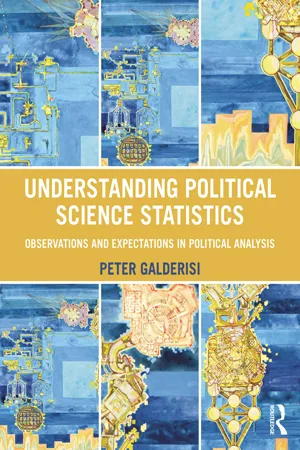
Understanding Political Science Statistics
Observations and Expectations in Political Analysis
- 340 pages
- English
- ePUB (mobile friendly)
- Available on iOS & Android
Understanding Political Science Statistics
Observations and Expectations in Political Analysis
About this book
In politics, you begin by asking theoretically interesting questions. Sometimes statistics can help answer those questions. When it comes to applied statistics, students shouldn't just learn a vast array of formula—they need to learn the basic concepts of statistics as solutions to particular problems. Peter Galderisi demonstrates that statistics are a summary of how to answer the problem: learn the math but only after learning the concepts and methodological considerations that give it context.
With this as a starting point, Understanding Political Science Statistics asks students to consider how to address a research problem conceptually before being led to the appropriate formula. Throughout, Galderisi looks at problems through a lens of "observations and expectations," which can be applied to myriad statistical techniques, both descriptive and inferential. This approach links the answers researchers get from their individual data analysis to the research designs and questions from which these analyses are derived.
By emphasizing the underlying logic of statistical analysis for greater understanding and drawing on applications and examples from political science (including law), the book illustrates how students can apply statistical concepts and techniques in their own research, in future coursework, and simply as an informed consumer of numbers in public discourse.
The following features help students master the material:
-
Legal and Methodological sidebars highlight key concepts and provide applied examples on law, politics, and methodology;
- End-of-chapter exercises allow students to test their mastery of the basic concepts and techniques along the way;
- A Sample Solutions Guide provides worked-out answers for odd-numbered exercises, with all answers available in the Instructor's Manual;
- Key Terms are helpfully called out in both Marginal Definitions and a Glossary;
- A Companion Website (www.routledge.com/cw/galderisi) with further resources for both students and instructors;
- A diverse array of data sets include subsets of the ANES and Eurobarometer surveys; CCES; US Congressional district data; and a cross-national dataset with political, economic, and demographic variables; and
- Companion guides to SPSS and Stata walk students through the procedures for analysis and provide exercises that go hand-in-hand with online data sets.
Frequently asked questions
- Essential is ideal for learners and professionals who enjoy exploring a wide range of subjects. Access the Essential Library with 800,000+ trusted titles and best-sellers across business, personal growth, and the humanities. Includes unlimited reading time and Standard Read Aloud voice.
- Complete: Perfect for advanced learners and researchers needing full, unrestricted access. Unlock 1.4M+ books across hundreds of subjects, including academic and specialized titles. The Complete Plan also includes advanced features like Premium Read Aloud and Research Assistant.
Please note we cannot support devices running on iOS 13 and Android 7 or earlier. Learn more about using the app.
Information
CHAPTER 1
Political Science, the Scientific Method, and Statistical Analysis
An Overview
CONTENTS
- The Language of Science
- The Structure of Hypotheses
- The Beauty of Hypotheses for Research
- The Logic of Causation—A Review
- Key Terms
- Questions and Exercises
Learning Objectives:
- To understand that political science can be studied scientifically
- To understand the language of science
- To understand what a hypothesis is and how it should be structured
- To understand the components necessary to make a causal argument
The Language of Science
Units of Analysis, Case, or Fact
- Peter Galderisi
- My dog, Treana
- The chair I’m now sitting on as I write this text
- The United States
- The European Union
- Congressman Darrell Issa (my current representative)
Properties, Concepts, and Variables
Laws and Hypotheses
In Nature | Our Guesses about Them | Our Measurements of Them |
|---|---|---|
Property | Concept | Variable |
Law | Hypothesis | Test Implication/Factual Statement |
Theories
- Experience—you have seen this occur so often that you are fairly certain about its predictive force (common sense). A myriad of observations have always met your expectations.
- Theoretical link—it can not only be predicted but also explained by the theory of gravity, stated simply as:
- Objects of mass greater than zero are attracted to each other.
- The attraction favors the object of greater mass.
- A limb has less mass than the earth.
- Therefore: if I cut a tree limb, it will “fall” to the ground unless held up by some other means.
Table of contents
- Cover
- Title
- Copyright
- Dedication
- Contents
- Tables, Figures, and Sidebars
- Preface
- 1 Political Science, the Scientific Method, and Statistical Analysis: An Overview
- 2 How Do We Measure and Observe?
- 3 Central Tendency as Summary Observation
- 4 Dispersion/Variation/Goodness of Fit as Summary Observation
- 5 Standardized Scores and Normal Distributions: The Concept of Relative Observation
- 6 An Intuitive Introduction to Inference and Hypothesis Testing
- 7 Hypothesis Testing and the Concept of Association: Observations and Expectations about the Difference between Means
- 8 Inferential Statistics for Proportions
- 9 Measuring Association for Nominal and Ordinal Data
- 10 Research Design and the Use of Control Variables
- 11 Different by How Much? Linear Regression
- 12 Retracing Our Methodological Steps: Hypotheses, Multiple Regression, and the Effects of Third Variables
- Concluding Remarks
- Glossary
- Sample Solutions Guide
- Index